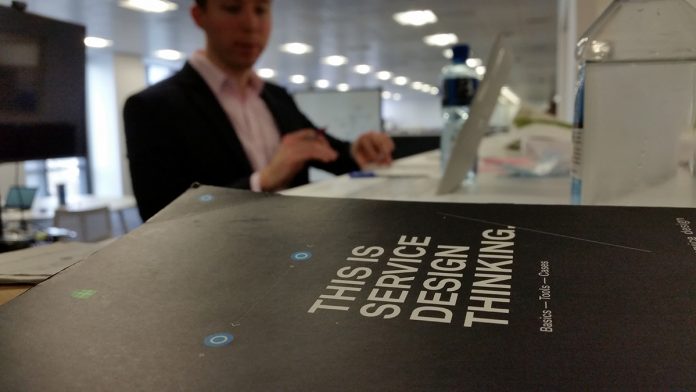Mark Hastings of Rainmaker Solutions offers public sector leaders some thoughts on how to accelerate their digital transformation journeys
Very few of you would argue against the seemingly irreversible trend for digital technologies and applications to reinvent and shape the way we work; the way we live our lives and the way we deliver public services.
The reality is, we can’t ignore it. We are being challenged daily to deliver better services, despite limited money and resources. Getting there requires departments to think and behave differently. But success will never be achieved through a one-off transformation programme.
If you are coming to the end of a long-term contract with a large Systems Integrator, or if you are wanting to use digital technologies to help deliver better services for less, here are our top five areas to focus on.
Understand where you are (situational awareness)
Every department will be starting their journey from a different place and with differing levels of digital maturity. We have learnt that situational awareness is a critical step in any transformation journey, but one that is often neglected.
If you don’t understand where you are, you can’t begin to plan how you are going to get to where you want to go. This is why we co-create visual maps of how users, processes and technology components interact to meet the organisation’s needs. It is these maps which help the department understand the environment in which it is operating and which will highlight how opportunities for strategic change may be exploited.
Understand where you are heading (clarity of purpose)
Every department needs a clear articulation of its vision; one that describes its desired future. To spell this out is to provide an aspirational destination for the organisation to head towards. Without clarity of vision and purpose, ambiguities are more likely to arise on the journey, leading to expensive changes of direction and increasing the time it takes to deliver.
Vision statements must be co-developed by listening to the views of those within an organisation, not simply imposed from the top without consultation. Done well, they will unite key stakeholders and provide a clear governance framework to support transformation delivery.
Focus on the user
At the heart of all transformations are people, not technology. Successful transformation starts by understanding user needs, pain points, user journeys and personas. It requires a service design approach to ensure that the services being designed meet those user needs. This involves working collaboratively across disciplines, engaging users and citizens to define, develop and embed transformation.
Too often, we see tools, systems and programmes being implemented without conducting sufficient user research, also known as ‘technology-led change’. This results in services which aren’t fit for purpose and which causes users to disengage from the service as their needs have not been met. In short, user research is essential. It crystallises the understanding around what users need to be able to do their jobs more easily or use a service with less effort. It means we are able to deliver more fundamental transformation by re-imagining services, rather than salami slicing existing services and cutting them to the bone.
Define a roadmap
The quickest route to failure is to try and fit new technologies to existing ways of working. In the long-term, it simply doesn’t work. True transformation must also address culture, workplace skills, leadership, governance and supplier relationships. It must be able to adapt to changing business requirements and changing user needs.
Having taken a user-centric approach to understanding where the department is and where it is headed, a transformation roadmap helps the department explore the path it needs to take to achieve its vision. They help it understand the way its people, processes, data and technology should combine to deliver value to its users. They inform decisions on where to act and why.
Iterative delivery
Collaboration is key. We like to call it ‘working out loud’. This is vital if transformation isn’t just to be ‘for Christmas’. It encourages all stakeholders to buy into the transformation plan, creating a culture which adopts digital at its core. It ensures the plan can endure ongoing iteration as circumstances change, whether due to market forces, product availability, organisational vision, performance or changing user needs.
It is through a detailed understanding of the department and its users, combined with a map of how their needs connect with technology, that we are able to work together to create a change in mindset, embedding digital change and transformation. Sometimes the answer will be ‘Agile’. Sometimes it won’t. But we start on that journey on day one and begin making real differences from the outset.
Flexibility
In a world where departments need to iterate constantly, a more flexible model for investing in technology and skills is needed. A framework that can respond to a more volatile, uncertain, complex and ambiguous world. Gone are the days of large outsourcing contracts, often single vendor arrangements, lasting from five to ten years. They no longer represent value for money and they constrain departments from achieving their visions.
Using proven partners and ‘as a service’ type models, which provide rapid access to skilled resources and the ability to scale according to the roadmap, can be a powerful way of achieving required outcomes. They allow departments to benefit from knowledge transfer in key skills like user research and analysis, agile project management and financial modelling. They avoid departments having to risk large investments in specialist in-house skills that may become irrelevant. If you hire a group of .NET developers, then they’ll see everything as a .NET development problem, whether that’s the right solution or not.
Conclusion
As a digital and business transformation business, we have helped many departments, agencies and local authorities accelerate their digital transformation journeys by taking a user-centred approach to transformation and using the department’s vision and values to guide it.
Most often, success stems from leadership teams who are prepared to question the status quo. From leaders who want to reimagine service delivery and ways of working. From leaders who want to challenge target operating models that are out-of-date as soon as they are implemented.
If you want to understand better where you are on your own journey, you can find us at rainmaker.solutions.
Mark Hastings 
Director of Public Sector
Rainmaker Solutions Limited
Tel: +44 (0)330 223 4407











